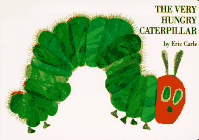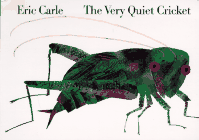Carol Hurst's Children's Literature Newsletter
Volume 2, Number 4. October, 1997. Page 4.
Written by Carol Hurst. Edited by Rebecca Otis.
![]()
This issue of the Children's Literature Newsletter is sponsored by:
Carol Hurst, Consultants.
Bringing children's literature to your workshop, conference and classroom.
![]()
Featured Author: Eric Carle

One of the most prolific and influential creators of children's picture books is Eric Carle. This engagingly unpretentious man has expanded our ideas of what a picture book has to be. Many of his books take us beyond the conventional rectangular shape with flat visuals. He thinks of his books as a step between home and school, between play and learning. Most of his creations have an educational element as well as foundations in the natural world.
In his most popular book, The Very Hungry Caterpillar (Putnam, 1986 ISBN 0-399-21301-5. Hardcover), he gives us pages of increasing size with holes in them which invite small fingers and peeking eyes. A careful look at that book reveals more of his genius. The endpapers give us the color scheme and an apparently random display of white dots but the three dimensional illusion starts with some overlapping dots of color using negative and positive space. The title page restores order with seven rows of dots in layers. That number seven occurs later in the days of the week. The dedication page gives us Carle's ubiquitous sun (it's in almost every book and seems to be his happy face). Although the first full page is exactly that, it appears that the left edge has been torn away to reveal the text. Also, on that page the dot has been slightly elongated and becomes the egg on the leaf.
Carle's illustrations become more and more exuberant as his work develops but he's stuck pretty much to the technique he uses in The Very Hungry Caterpillar, glueing several layers of tissue paper on a white background. He then uses paint and crayon to create more variety of color and texture. Cutting pieces out of that "self-made" paper, he then assembles his creations. This technique gives a vibrant, free feeling to his illustrations.

Pages fold out and double, even triple in size in other Carle books. Texture, which adds a third dimension to the book, occurs in Very Busy Spider. Adding sound to Very Quiet Cricket and light to Very Lonely Firefly keeps our concept of a picture book from becoming rigid, at least when we're in the world of Eric Carle.
Eric Carle was born in Syracuse, New York in 1929. His parents, who had come from Germany moved the family back there in 1935. Under the Nazi regime in Germany, the school curriculum, including the art program, was very rigid. One art teacher, seeing Carle's talent, brought him to his home to view non-representational art, a crime in Nazi Germany. In 1951, Eric returned to New York to find work in the field of commercial art. His father, who had worked in the United States before the war and was still thinking of that Depression economy, cautioned Eric not to take employment for less than $40 per week, a very low wage in 1951. Eric Carle illustrated his first children's book for Bill Martin, Jr., Brown Bear, Brown Bear in 1967.
For many years Eric Carle and his wife lived on a mountain in the Berkshires. They now live in Northampton, MA. For more information about the artist and his work, check out Eric Carle's website at http://www.eric-carle.com/. It's fun and informative for kids as well as adult admirers of his work.
Some of Carle's Best:
Do You Want to Be My Friend? HarperCollins, 1987 ISBN 0-06-443127-4. Hardcover, Library Binding, Paperback, Board book.
- In this book for very young children, we see the tail of each animal before we turn to find out which animal the mouse wants for a friend.
Draw Me a Star Putnam, 1992 ISBN 0-399-21877-7. Library Binding.
- An artist draws a star which asks him to draw a sun and so on through a chain of drawings.
The Grouchy Ladybug HarperCollins, 1986 ISBN 0-06-443116-9. Hardcover, Library Binding, Paperback, Spanish.
- A ladybug challenges ever bigger animals to a fight as the time of day (exhibited on each page) goes on. Eventually a whale flips the ladybug with its tale with such strength that the ladybug ends up back on the leaf it started with.
Have You Seen My Cat? Picture Book Studio, 1987 ISBN 0-88708-054-5. Hardcover, Paperback, Board Book.
- A boy loses his cat and sets off to find it. He sees many other large cats but none are his pet. Returning home, he finds his cat with her kittens.
A House for Hermit Crab Picture Book Studio, 1991 ISBN 0-88708-056-1. Hardcover.
- It's the nature of a hermit crab to move into bigger and bigger houses (shells) as it grows. This one, however, is particularly reluctant to leave the home his friends helped decorate.
I See a Song HarperCollins, 1973 ISBN 0-690-43307-7. Paperback.
- In this wordless book, a song is played and the feelings and visions it invokes are shown.
The Mixed-Up Chameleon Harper, 1984 ISBN 0-690-04397-X. Hardcover, Paperback, Library Binding.
- A chameleon tries to be many animals before deciding that the original chameleon was the best.
One, Two, Three to the Zoo Putnam, 1990 ISBN 0-399-21970-6. Paperback.
- In this counting book, we watch a train bearing animals on its way to the zoo.
Pancakes, Pancakes Scholastic, 1992 ISBN 0-590-44453-0. Paperback.
- This little boy wants pancakes for breakfast and will accept no substitutes.
Papa, Please Get the Moon for Me Picture Book Studio, 1991 ISBN 0-88708-026-X. Hardcover.
- His daughter wants the moon and so he climbs a very tall ladder to get it. He gets to the moon but finds it's too large to bring home.
Rooster's Off to See the World Picture Book Studio, 1991 ISBN 0-88708-042-1. Miniature.
- In this counting book, animals gather to go with Rooster on his journey. One by one they come and one by one they tire and leave.
Secret Birthday Message HarperCollins, 1986 ISBN 0-06-443099-5. Hardcover, Paperback, Library Binding.
- We follow the directions on a message through (often literally through) holes and shapes in the page to find a birthday surprise.
 The Tiny Seed Picture Book Studio, 1991 ISBN 0-88708-015-4. Hardcover.
The Tiny Seed Picture Book Studio, 1991 ISBN 0-88708-015-4. Hardcover.
- We follow a seed from birth to flower to seed again. Read our Featured Book Teachers Guide with a review, discussion ideas, activities, related books and links.
Today Is Monday Putnam, 1993 ISBN 0-399-21966-8. Paperback, Library Binding.
- The common folksong is used as a backdrop for the animals who show up for spaghetti Tuesday, Wednesday's soup, etc.
The Very Busy Spider Putnam, 1989 ISBN 0-399-21166-7. Board book, Hardcover, Paperback.
- With the threads of the web raised from the page, this book has a three dimensional look as, one after another, animals ask the spider to come and play. The patterned text makes this easy to read and worth the effort.
The Very Hungry Caterpillar Putnam, 1986 ISBN 0-399-21301-5. Hardcover, Board Book.
- This classic has been the delight of many generations of children as they travel through Carle's cut-out and varying sized pages together with a caterpillar.
The Very Lonely Firefly Putnam, 1995 ISBN 0-399-2274-1. Library Binding.
- In search of a friend, a firefly follows many lights but finds only a candle, a flashlight, a lantern, a cat, headlights and fireworks before finding a page full of fireflies with lights that really shine.
The Very Quiet Cricket Putnam, 1990 ISBN 0-399-21885-8. Hardcover, Board Book.
- In this lovely patterned book, we watch the insects of the day and night as a little cricket, wanting to make a sound, finds his voice and a mate and we hear the sound.
![]()
Go to Next Section of Newsletter, Notes from the Road.
Return to Table of Contents of the Newsletter.
Advertisement:
Advertisement:
Advertisement:

